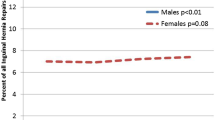Abstract
Background
Femoral hernias are frequently operated on as an emergency. Emergency procedures for femoral hernia are associated with an almost tenfold increase in postoperative mortality, while no increase is seen for elective procedures, compared with a background population.
Objective
The aim of this study was to compare whether symptoms from femoral hernias and healthcare contacts prior to surgery differ between patients who have elective and patients who have emergency surgery.
Methods
A total of 1,967 individuals operated on for a femoral hernia over 1997–2006 were sent a questionnaire on symptoms experienced and contact with the healthcare system prior to surgery for their hernia. Answers were matched with data from the Swedish Hernia Register.
Results
A total of 1,441 (73.3 %) patients responded. Awareness of their hernia prior to surgery was denied by 53.3 % (231/433) of those who underwent an emergency procedure. Of the emergency operated patients, 31.3 % (135/432) negated symptoms in the affected groin prior to surgery and 22.2 % (96/432) had neither groin nor other symptoms. Elective patients had a considerably higher contact frequency with their general practitioner, as well as the surgical outpatient department, prior to surgery compared with patients undergoing emergency surgery (p < 0.001).
Conclusions
Patients who have elective and patients who have emergency femoral hernia surgery differ in previous symptoms and healthcare contacts. Patients who need emergency surgery are often unaware of their hernia and frequently completely asymptomatic prior to incarceration. Early diagnosis and expedient surgery is warranted, but the lack of symptoms hinders earlier detection and intervention in most cases.

Similar content being viewed by others
References
Glassow F (1985) Femoral hernia: review of 2,105 repairs in a 17 year period. Am J Surg 150:353–356
Bay-Nielsen M, Kehlet H, Strand L et al (2001) Quality assessment of 26,304 herniorrhaphies in Denmark: a prospective nationwide study. Lancet 358:1124–1128
Dahlstrand U, Wollert S, Nordin P et al (2009) Emergency femoral hernia repair: a study based on a national register. Ann Surg 249:672–676
Kulah B, Kulacoglu IH, Oruc MT et al (2001) Presentation and outcome of incarcerated external hernias in adults. Am J Surg 181:101–104
Kurt N, Oncel M, Ozkan Z et al (2003) Risk and outcome of bowel resection in patients with incarcerated groin hernias: retrospective study. World J Surg 27:741–743. doi:10.1007/s00268-003-6826-x
Alvarez JA, Baldonedo RF, Bear IG et al (2004) Incarcerated groin hernias in adults: presentation and outcome. Hernia 8:121–126
Ge BJ, Huang Q, Liu LM et al (2010) Risk factors for bowel resection and outcome in patients with incarcerated groin hernias. Hernia 14:259–264
van den Heuvel B, Dwars BJ, Klassen DR et al (2011) Is surgical repair of an asymptomatic groin hernia appropriate? A review. Hernia 15:251–259
Gunnarsson U, Degerman M, Davidsson A et al (1999) Is elective hernia repair worthwhile in old patients? Eur J Surg 165:326–332
Nilsson H, Stylianidis G, Haapamaki M et al (2007) Mortality after groin hernia surgery. Ann Surg 245:656–660
Dahlstrand U, Sandblom G, Nordin P et al (2011) Chronic pain after femoral hernia repair: a cross-sectional study. Ann Surg 254:1017–1021
McEntee GP, O’Carroll A, Mooney B et al (1989) Timing of strangulation in adult hernias. Br J Surg 76:725–726
Roth N, Gangl O, Havlicek W et al (2010) The impact of emergency surgery on results of femoral hernia repair. Eur Surg 42:299–303
Alani A, Page B, O’Dwyer PJ (2006) Prospective study on the presentation and outcome of patients with an acute hernia. Hernia 10:62–65
Tiernan JP, Katsarelis H, Garner JP et al (2010) Excellent outcomes after emergency groin hernia repair. Hernia 14:485–488
Malek S, Torella F, Edwards PR (2004) Emergency repair of groin herniae: outcome and implications for elective surgery waiting times. Int J Clin Pract 58:207–209
Nilsson E, Haapaniemi S, Gruber G et al (1998) Methods of repair and risk for reoperation in Swedish hernia surgery from 1992 to 1996. Br J Surg 85:1686–1691
Ludvigsson JF, Otterblad-Olausson P, Pettersson BU et al (2009) The Swedish personal identity number: possibilities and pitfalls in healthcare and medical research. Eur J Epidemiol 24:659–667
von Elm E, Altman DG, Egger M et al (2007) The Strengthening the Reporting of Observational Studies in Epidemiology (STROBE) statement: guidelines for reporting observational studies. Lancet 370:1453–1457
Rai S, Chandra SS, Smile SR (1998) A study of the risk of strangulation and obstruction in groin hernias. Aust N Z J Surg 68:650–654
Humes DJ, Radcliffe RS, Camm C et al (2013) Population-based study of presentation and adverse outcomes after femoral hernia surgery. Br J Surg 100:1827–1832
Suppiah A, Gatt M, Barandiaran J et al (2007) Outcomes of emergency and elective femoral hernia surgery in four district general hospitals: a 4-year study. Hernia 11:509–512
Abi-Haidar Y, Sanchez V, Itani K (2011) Risk factors and outcomes of acute versus elective groin hernia surgery. J Am Coll Surg 213:363–369
Gallegos NC, Dawson J, Jarvis M et al (1991) Risk of strangulation in groin hernias. Br J Surg 78:1171–1173
Simons MP, Aufenacker T, Bay-Nielsen M et al (2009) European Hernia Society guidelines on the treatment of inguinal hernia in adult patients. Hernia 13:343–403
Rosemar A, Angerås U, Rosengren A et al (2010) Effect of body mass index on groin hernia surgery. Ann Surg 252:397–401
Nilsson H, Nilsson E, Angeras U et al (2011) Mortality after groin hernia surgery: delay of treatment and cause of death. Hernia 15(3):301–307
Kjaergaard J, Bay-Nielsen M, Kehlet H (2010) Mortality following emergency groin hernia surgery in Denmark. Hernia 14:351–355
Acknowledgments
The work was funded by grants from Uppsala-Örebro Regional Research Council and Stockholm County Council.
Conflict of interest
The authors declare no conflicts of interest.
Author information
Authors and Affiliations
Corresponding author
Electronic supplementary material
Below is the link to the electronic supplementary material.
Rights and permissions
About this article
Cite this article
Dahlstrand, U., Sandblom, G., Wollert, S. et al. Limited Potential for Prevention of Emergency Surgery for Femoral Hernia. World J Surg 38, 1931–1936 (2014). https://doi.org/10.1007/s00268-014-2539-6
Published:
Issue Date:
DOI: https://doi.org/10.1007/s00268-014-2539-6




